Repetitive Transcranial Magnetic Stimulation for Cognitive Improvement
VerifiedAdded on 2023/04/24
|9
|2368
|378
Essay
AI Summary
This essay provides a comprehensive analysis of repetitive transcranial magnetic stimulation (rTMS) as a non-invasive brain stimulation technique and its effects on cognitive function. The essay argues that rTMS is a safe and feasible treatment, improving memory, executive function, and overall performance in various settings. Through a review of scholarly articles, the essay highlights rTMS's potential in treating conditions like depression, Alzheimer's, and stroke by enhancing neuroplasticity and improving cognitive abilities. The discussion covers safety considerations, cognitive benefits in memory and executive functioning, and the generalization of improvements to other settings. The essay concludes that rTMS holds promise for cognitive enhancement, particularly in individuals with neurocognitive impairments, and suggests its consideration for future treatment applications. The essay uses several studies and trials to support its claims and demonstrates the potential of rTMS in improving mood, motor skills, and overall quality of life.
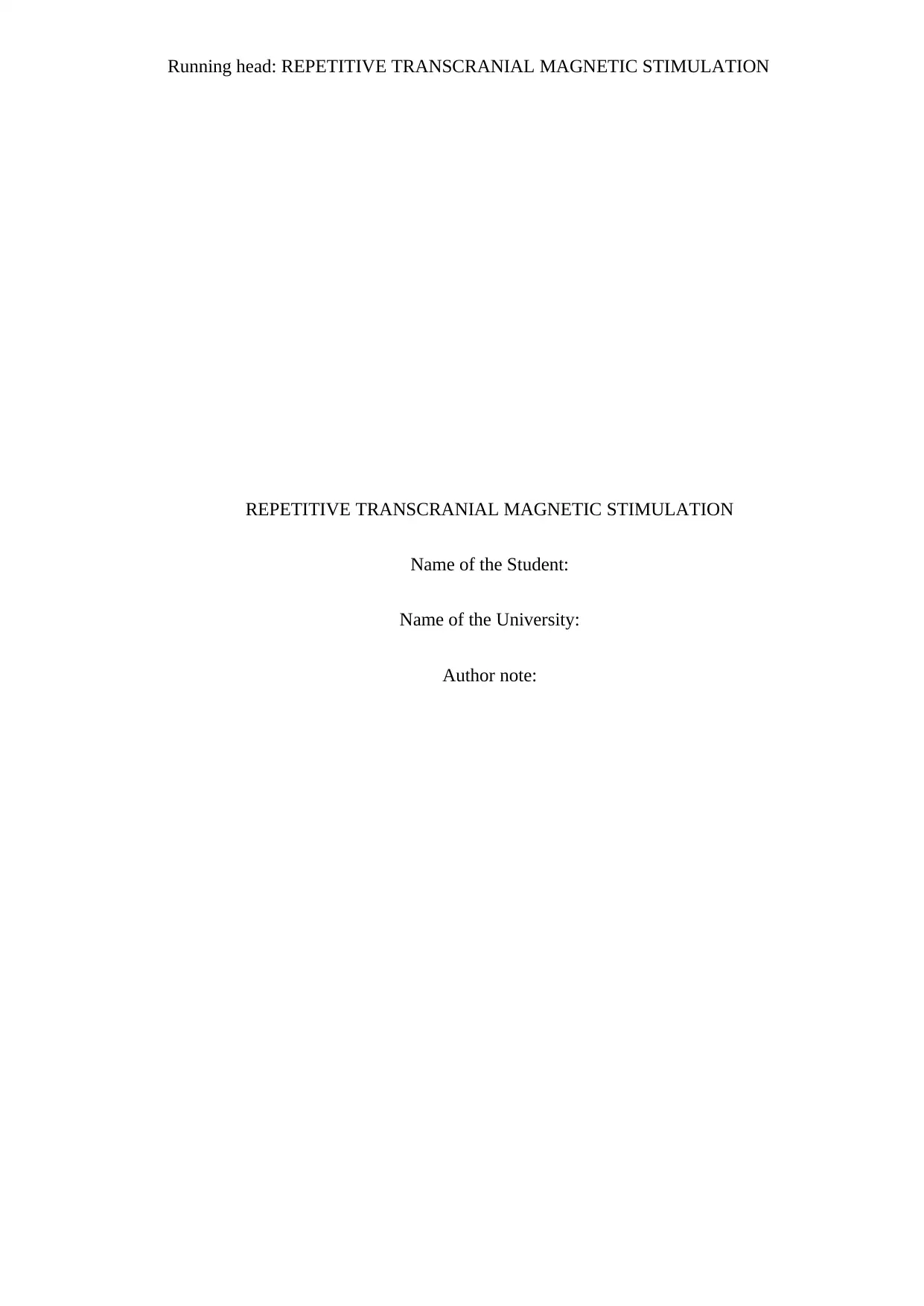
Running head: REPETITIVE TRANSCRANIAL MAGNETIC STIMULATION
REPETITIVE TRANSCRANIAL MAGNETIC STIMULATION
Name of the Student:
Name of the University:
Author note:
REPETITIVE TRANSCRANIAL MAGNETIC STIMULATION
Name of the Student:
Name of the University:
Author note:
Paraphrase This Document
Need a fresh take? Get an instant paraphrase of this document with our AI Paraphraser
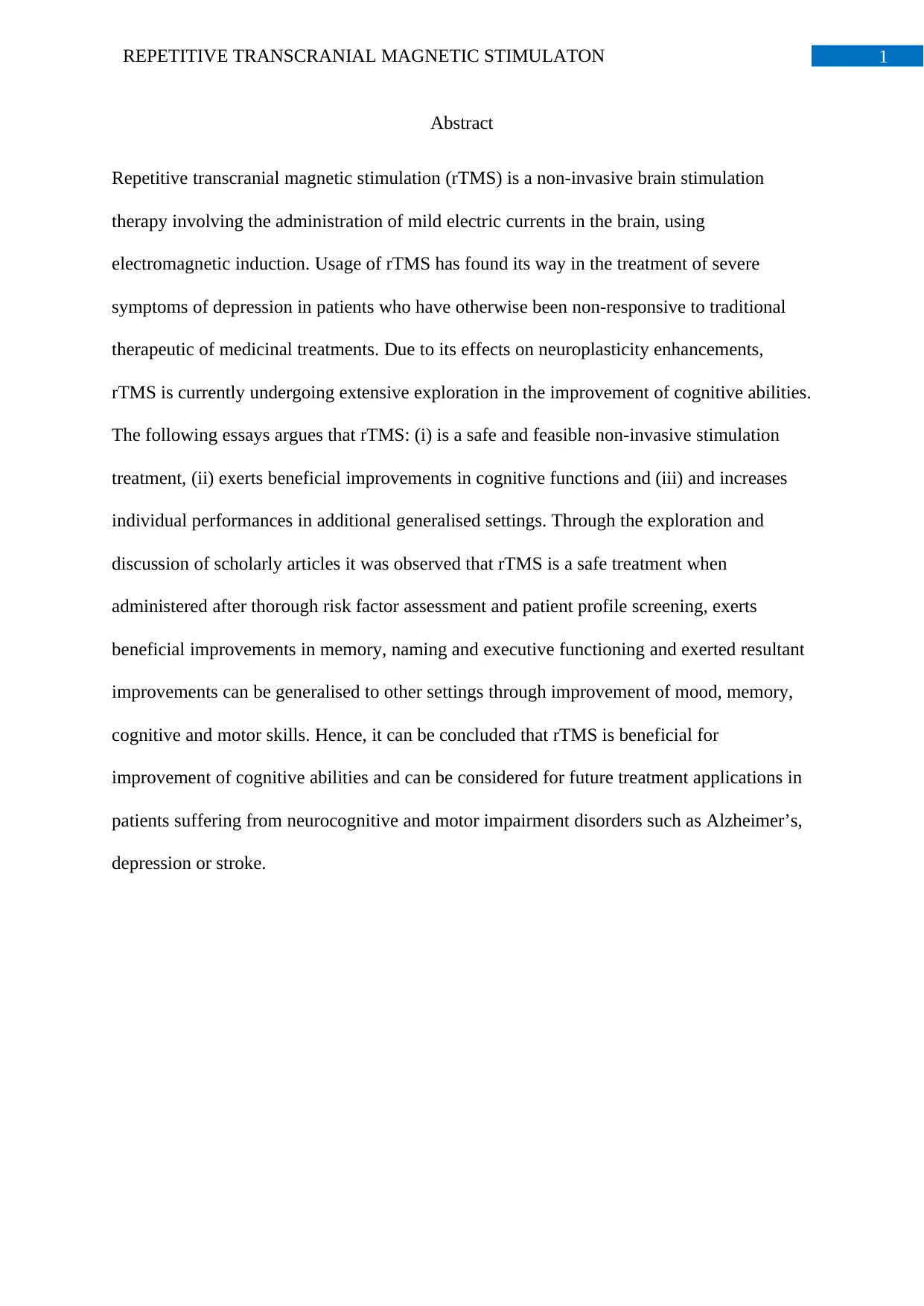
1REPETITIVE TRANSCRANIAL MAGNETIC STIMULATON
Abstract
Repetitive transcranial magnetic stimulation (rTMS) is a non-invasive brain stimulation
therapy involving the administration of mild electric currents in the brain, using
electromagnetic induction. Usage of rTMS has found its way in the treatment of severe
symptoms of depression in patients who have otherwise been non-responsive to traditional
therapeutic of medicinal treatments. Due to its effects on neuroplasticity enhancements,
rTMS is currently undergoing extensive exploration in the improvement of cognitive abilities.
The following essays argues that rTMS: (i) is a safe and feasible non-invasive stimulation
treatment, (ii) exerts beneficial improvements in cognitive functions and (iii) and increases
individual performances in additional generalised settings. Through the exploration and
discussion of scholarly articles it was observed that rTMS is a safe treatment when
administered after thorough risk factor assessment and patient profile screening, exerts
beneficial improvements in memory, naming and executive functioning and exerted resultant
improvements can be generalised to other settings through improvement of mood, memory,
cognitive and motor skills. Hence, it can be concluded that rTMS is beneficial for
improvement of cognitive abilities and can be considered for future treatment applications in
patients suffering from neurocognitive and motor impairment disorders such as Alzheimer’s,
depression or stroke.
Abstract
Repetitive transcranial magnetic stimulation (rTMS) is a non-invasive brain stimulation
therapy involving the administration of mild electric currents in the brain, using
electromagnetic induction. Usage of rTMS has found its way in the treatment of severe
symptoms of depression in patients who have otherwise been non-responsive to traditional
therapeutic of medicinal treatments. Due to its effects on neuroplasticity enhancements,
rTMS is currently undergoing extensive exploration in the improvement of cognitive abilities.
The following essays argues that rTMS: (i) is a safe and feasible non-invasive stimulation
treatment, (ii) exerts beneficial improvements in cognitive functions and (iii) and increases
individual performances in additional generalised settings. Through the exploration and
discussion of scholarly articles it was observed that rTMS is a safe treatment when
administered after thorough risk factor assessment and patient profile screening, exerts
beneficial improvements in memory, naming and executive functioning and exerted resultant
improvements can be generalised to other settings through improvement of mood, memory,
cognitive and motor skills. Hence, it can be concluded that rTMS is beneficial for
improvement of cognitive abilities and can be considered for future treatment applications in
patients suffering from neurocognitive and motor impairment disorders such as Alzheimer’s,
depression or stroke.
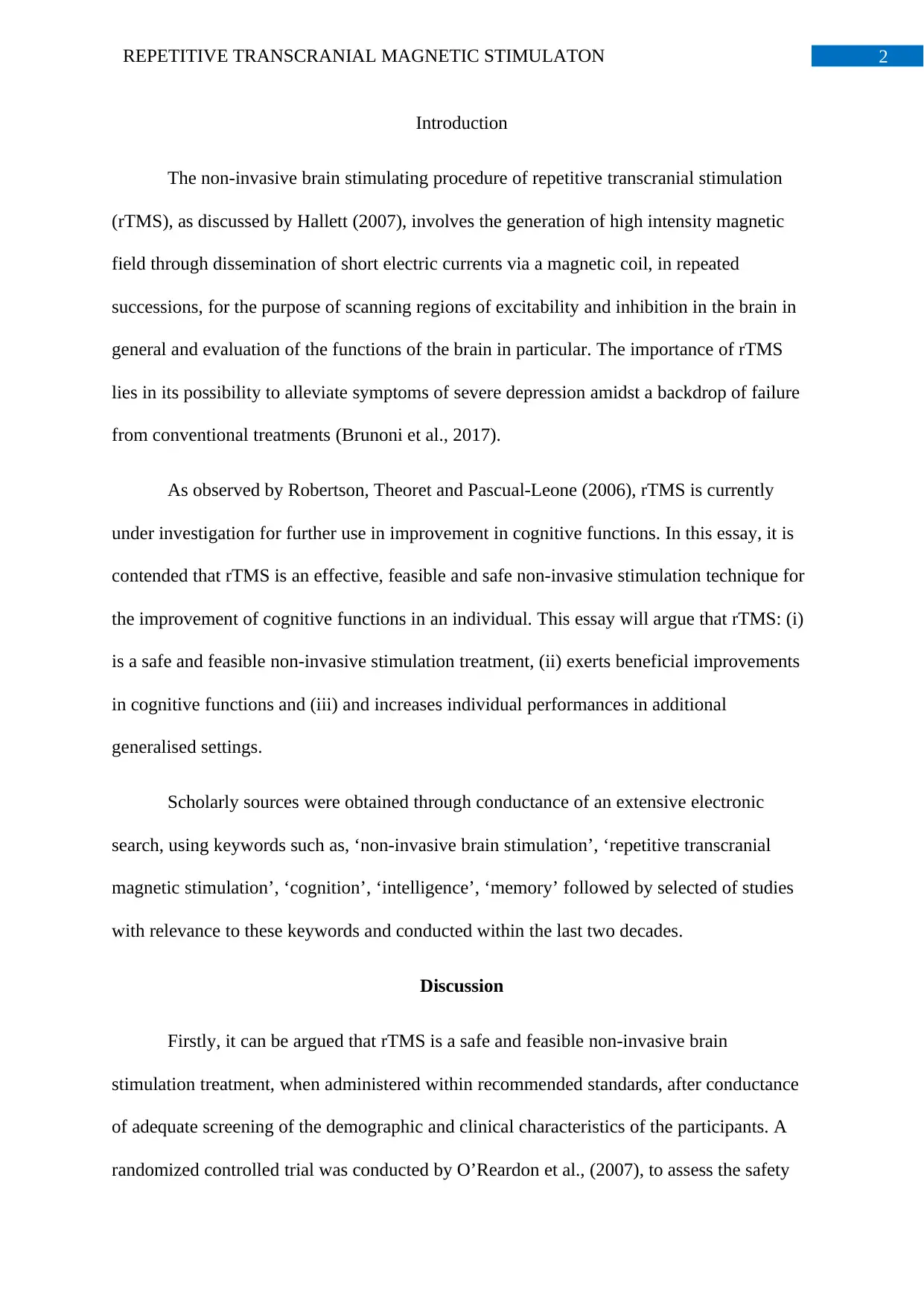
2REPETITIVE TRANSCRANIAL MAGNETIC STIMULATON
Introduction
The non-invasive brain stimulating procedure of repetitive transcranial stimulation
(rTMS), as discussed by Hallett (2007), involves the generation of high intensity magnetic
field through dissemination of short electric currents via a magnetic coil, in repeated
successions, for the purpose of scanning regions of excitability and inhibition in the brain in
general and evaluation of the functions of the brain in particular. The importance of rTMS
lies in its possibility to alleviate symptoms of severe depression amidst a backdrop of failure
from conventional treatments (Brunoni et al., 2017).
As observed by Robertson, Theoret and Pascual-Leone (2006), rTMS is currently
under investigation for further use in improvement in cognitive functions. In this essay, it is
contended that rTMS is an effective, feasible and safe non-invasive stimulation technique for
the improvement of cognitive functions in an individual. This essay will argue that rTMS: (i)
is a safe and feasible non-invasive stimulation treatment, (ii) exerts beneficial improvements
in cognitive functions and (iii) and increases individual performances in additional
generalised settings.
Scholarly sources were obtained through conductance of an extensive electronic
search, using keywords such as, ‘non-invasive brain stimulation’, ‘repetitive transcranial
magnetic stimulation’, ‘cognition’, ‘intelligence’, ‘memory’ followed by selected of studies
with relevance to these keywords and conducted within the last two decades.
Discussion
Firstly, it can be argued that rTMS is a safe and feasible non-invasive brain
stimulation treatment, when administered within recommended standards, after conductance
of adequate screening of the demographic and clinical characteristics of the participants. A
randomized controlled trial was conducted by O’Reardon et al., (2007), to assess the safety
Introduction
The non-invasive brain stimulating procedure of repetitive transcranial stimulation
(rTMS), as discussed by Hallett (2007), involves the generation of high intensity magnetic
field through dissemination of short electric currents via a magnetic coil, in repeated
successions, for the purpose of scanning regions of excitability and inhibition in the brain in
general and evaluation of the functions of the brain in particular. The importance of rTMS
lies in its possibility to alleviate symptoms of severe depression amidst a backdrop of failure
from conventional treatments (Brunoni et al., 2017).
As observed by Robertson, Theoret and Pascual-Leone (2006), rTMS is currently
under investigation for further use in improvement in cognitive functions. In this essay, it is
contended that rTMS is an effective, feasible and safe non-invasive stimulation technique for
the improvement of cognitive functions in an individual. This essay will argue that rTMS: (i)
is a safe and feasible non-invasive stimulation treatment, (ii) exerts beneficial improvements
in cognitive functions and (iii) and increases individual performances in additional
generalised settings.
Scholarly sources were obtained through conductance of an extensive electronic
search, using keywords such as, ‘non-invasive brain stimulation’, ‘repetitive transcranial
magnetic stimulation’, ‘cognition’, ‘intelligence’, ‘memory’ followed by selected of studies
with relevance to these keywords and conducted within the last two decades.
Discussion
Firstly, it can be argued that rTMS is a safe and feasible non-invasive brain
stimulation treatment, when administered within recommended standards, after conductance
of adequate screening of the demographic and clinical characteristics of the participants. A
randomized controlled trial was conducted by O’Reardon et al., (2007), to assess the safety
⊘ This is a preview!⊘
Do you want full access?
Subscribe today to unlock all pages.

Trusted by 1+ million students worldwide
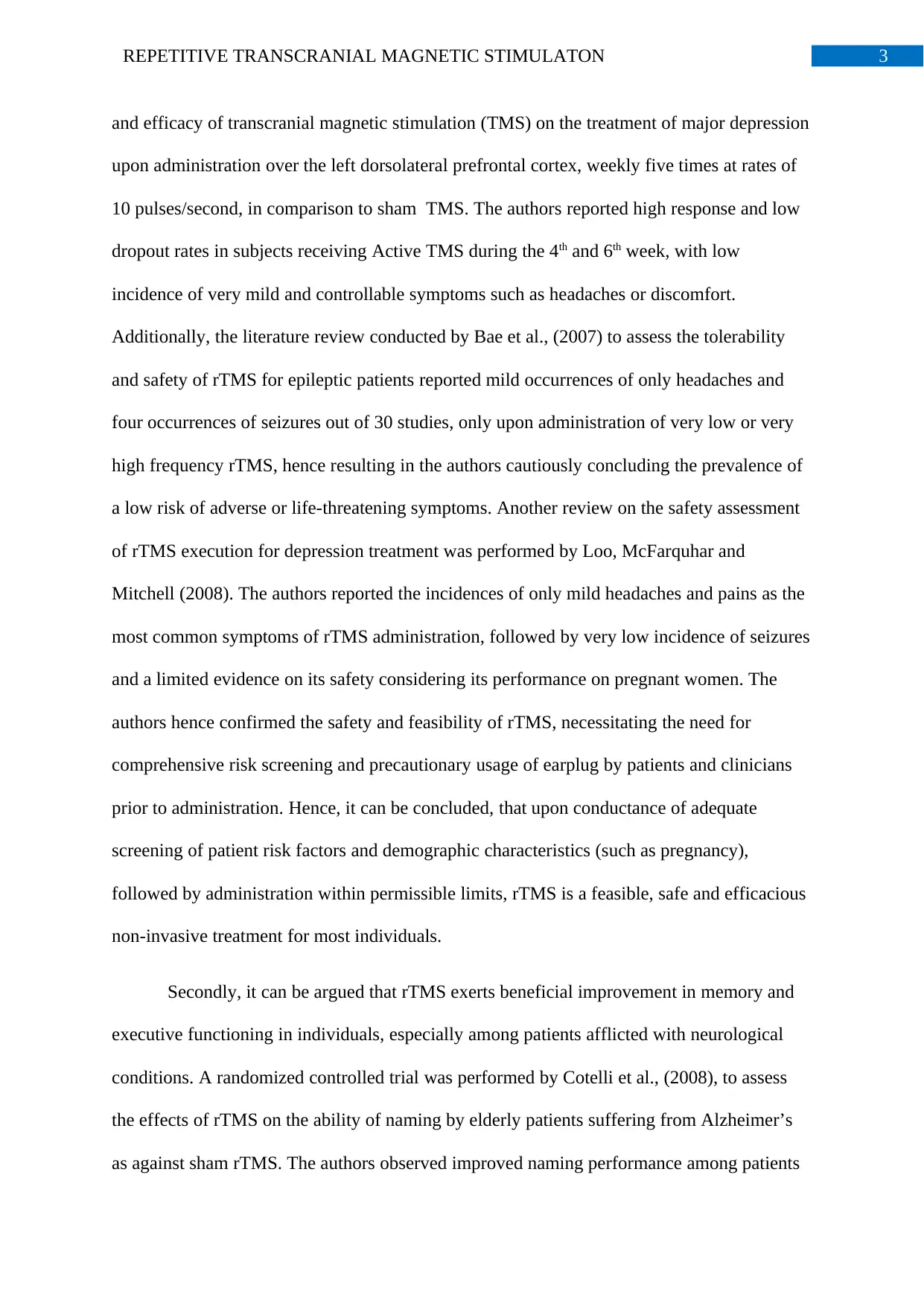
3REPETITIVE TRANSCRANIAL MAGNETIC STIMULATON
and efficacy of transcranial magnetic stimulation (TMS) on the treatment of major depression
upon administration over the left dorsolateral prefrontal cortex, weekly five times at rates of
10 pulses/second, in comparison to sham TMS. The authors reported high response and low
dropout rates in subjects receiving Active TMS during the 4th and 6th week, with low
incidence of very mild and controllable symptoms such as headaches or discomfort.
Additionally, the literature review conducted by Bae et al., (2007) to assess the tolerability
and safety of rTMS for epileptic patients reported mild occurrences of only headaches and
four occurrences of seizures out of 30 studies, only upon administration of very low or very
high frequency rTMS, hence resulting in the authors cautiously concluding the prevalence of
a low risk of adverse or life-threatening symptoms. Another review on the safety assessment
of rTMS execution for depression treatment was performed by Loo, McFarquhar and
Mitchell (2008). The authors reported the incidences of only mild headaches and pains as the
most common symptoms of rTMS administration, followed by very low incidence of seizures
and a limited evidence on its safety considering its performance on pregnant women. The
authors hence confirmed the safety and feasibility of rTMS, necessitating the need for
comprehensive risk screening and precautionary usage of earplug by patients and clinicians
prior to administration. Hence, it can be concluded, that upon conductance of adequate
screening of patient risk factors and demographic characteristics (such as pregnancy),
followed by administration within permissible limits, rTMS is a feasible, safe and efficacious
non-invasive treatment for most individuals.
Secondly, it can be argued that rTMS exerts beneficial improvement in memory and
executive functioning in individuals, especially among patients afflicted with neurological
conditions. A randomized controlled trial was performed by Cotelli et al., (2008), to assess
the effects of rTMS on the ability of naming by elderly patients suffering from Alzheimer’s
as against sham rTMS. The authors observed improved naming performance among patients
and efficacy of transcranial magnetic stimulation (TMS) on the treatment of major depression
upon administration over the left dorsolateral prefrontal cortex, weekly five times at rates of
10 pulses/second, in comparison to sham TMS. The authors reported high response and low
dropout rates in subjects receiving Active TMS during the 4th and 6th week, with low
incidence of very mild and controllable symptoms such as headaches or discomfort.
Additionally, the literature review conducted by Bae et al., (2007) to assess the tolerability
and safety of rTMS for epileptic patients reported mild occurrences of only headaches and
four occurrences of seizures out of 30 studies, only upon administration of very low or very
high frequency rTMS, hence resulting in the authors cautiously concluding the prevalence of
a low risk of adverse or life-threatening symptoms. Another review on the safety assessment
of rTMS execution for depression treatment was performed by Loo, McFarquhar and
Mitchell (2008). The authors reported the incidences of only mild headaches and pains as the
most common symptoms of rTMS administration, followed by very low incidence of seizures
and a limited evidence on its safety considering its performance on pregnant women. The
authors hence confirmed the safety and feasibility of rTMS, necessitating the need for
comprehensive risk screening and precautionary usage of earplug by patients and clinicians
prior to administration. Hence, it can be concluded, that upon conductance of adequate
screening of patient risk factors and demographic characteristics (such as pregnancy),
followed by administration within permissible limits, rTMS is a feasible, safe and efficacious
non-invasive treatment for most individuals.
Secondly, it can be argued that rTMS exerts beneficial improvement in memory and
executive functioning in individuals, especially among patients afflicted with neurological
conditions. A randomized controlled trial was performed by Cotelli et al., (2008), to assess
the effects of rTMS on the ability of naming by elderly patients suffering from Alzheimer’s
as against sham rTMS. The authors observed improved naming performance among patients
Paraphrase This Document
Need a fresh take? Get an instant paraphrase of this document with our AI Paraphraser
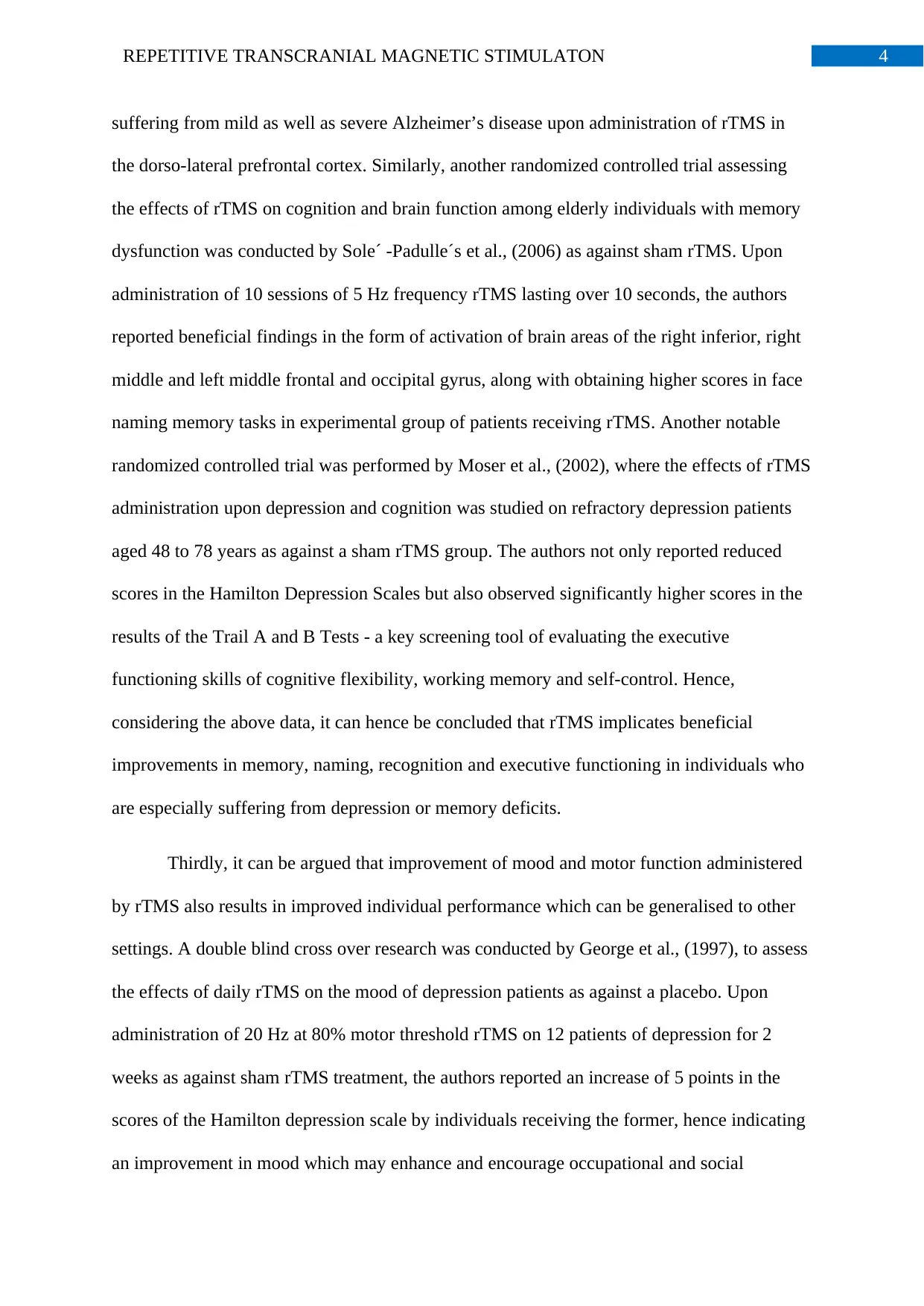
4REPETITIVE TRANSCRANIAL MAGNETIC STIMULATON
suffering from mild as well as severe Alzheimer’s disease upon administration of rTMS in
the dorso-lateral prefrontal cortex. Similarly, another randomized controlled trial assessing
the effects of rTMS on cognition and brain function among elderly individuals with memory
dysfunction was conducted by Sole´ -Padulle´s et al., (2006) as against sham rTMS. Upon
administration of 10 sessions of 5 Hz frequency rTMS lasting over 10 seconds, the authors
reported beneficial findings in the form of activation of brain areas of the right inferior, right
middle and left middle frontal and occipital gyrus, along with obtaining higher scores in face
naming memory tasks in experimental group of patients receiving rTMS. Another notable
randomized controlled trial was performed by Moser et al., (2002), where the effects of rTMS
administration upon depression and cognition was studied on refractory depression patients
aged 48 to 78 years as against a sham rTMS group. The authors not only reported reduced
scores in the Hamilton Depression Scales but also observed significantly higher scores in the
results of the Trail A and B Tests - a key screening tool of evaluating the executive
functioning skills of cognitive flexibility, working memory and self-control. Hence,
considering the above data, it can hence be concluded that rTMS implicates beneficial
improvements in memory, naming, recognition and executive functioning in individuals who
are especially suffering from depression or memory deficits.
Thirdly, it can be argued that improvement of mood and motor function administered
by rTMS also results in improved individual performance which can be generalised to other
settings. A double blind cross over research was conducted by George et al., (1997), to assess
the effects of daily rTMS on the mood of depression patients as against a placebo. Upon
administration of 20 Hz at 80% motor threshold rTMS on 12 patients of depression for 2
weeks as against sham rTMS treatment, the authors reported an increase of 5 points in the
scores of the Hamilton depression scale by individuals receiving the former, hence indicating
an improvement in mood which may enhance and encourage occupational and social
suffering from mild as well as severe Alzheimer’s disease upon administration of rTMS in
the dorso-lateral prefrontal cortex. Similarly, another randomized controlled trial assessing
the effects of rTMS on cognition and brain function among elderly individuals with memory
dysfunction was conducted by Sole´ -Padulle´s et al., (2006) as against sham rTMS. Upon
administration of 10 sessions of 5 Hz frequency rTMS lasting over 10 seconds, the authors
reported beneficial findings in the form of activation of brain areas of the right inferior, right
middle and left middle frontal and occipital gyrus, along with obtaining higher scores in face
naming memory tasks in experimental group of patients receiving rTMS. Another notable
randomized controlled trial was performed by Moser et al., (2002), where the effects of rTMS
administration upon depression and cognition was studied on refractory depression patients
aged 48 to 78 years as against a sham rTMS group. The authors not only reported reduced
scores in the Hamilton Depression Scales but also observed significantly higher scores in the
results of the Trail A and B Tests - a key screening tool of evaluating the executive
functioning skills of cognitive flexibility, working memory and self-control. Hence,
considering the above data, it can hence be concluded that rTMS implicates beneficial
improvements in memory, naming, recognition and executive functioning in individuals who
are especially suffering from depression or memory deficits.
Thirdly, it can be argued that improvement of mood and motor function administered
by rTMS also results in improved individual performance which can be generalised to other
settings. A double blind cross over research was conducted by George et al., (1997), to assess
the effects of daily rTMS on the mood of depression patients as against a placebo. Upon
administration of 20 Hz at 80% motor threshold rTMS on 12 patients of depression for 2
weeks as against sham rTMS treatment, the authors reported an increase of 5 points in the
scores of the Hamilton depression scale by individuals receiving the former, hence indicating
an improvement in mood which may enhance and encourage occupational and social
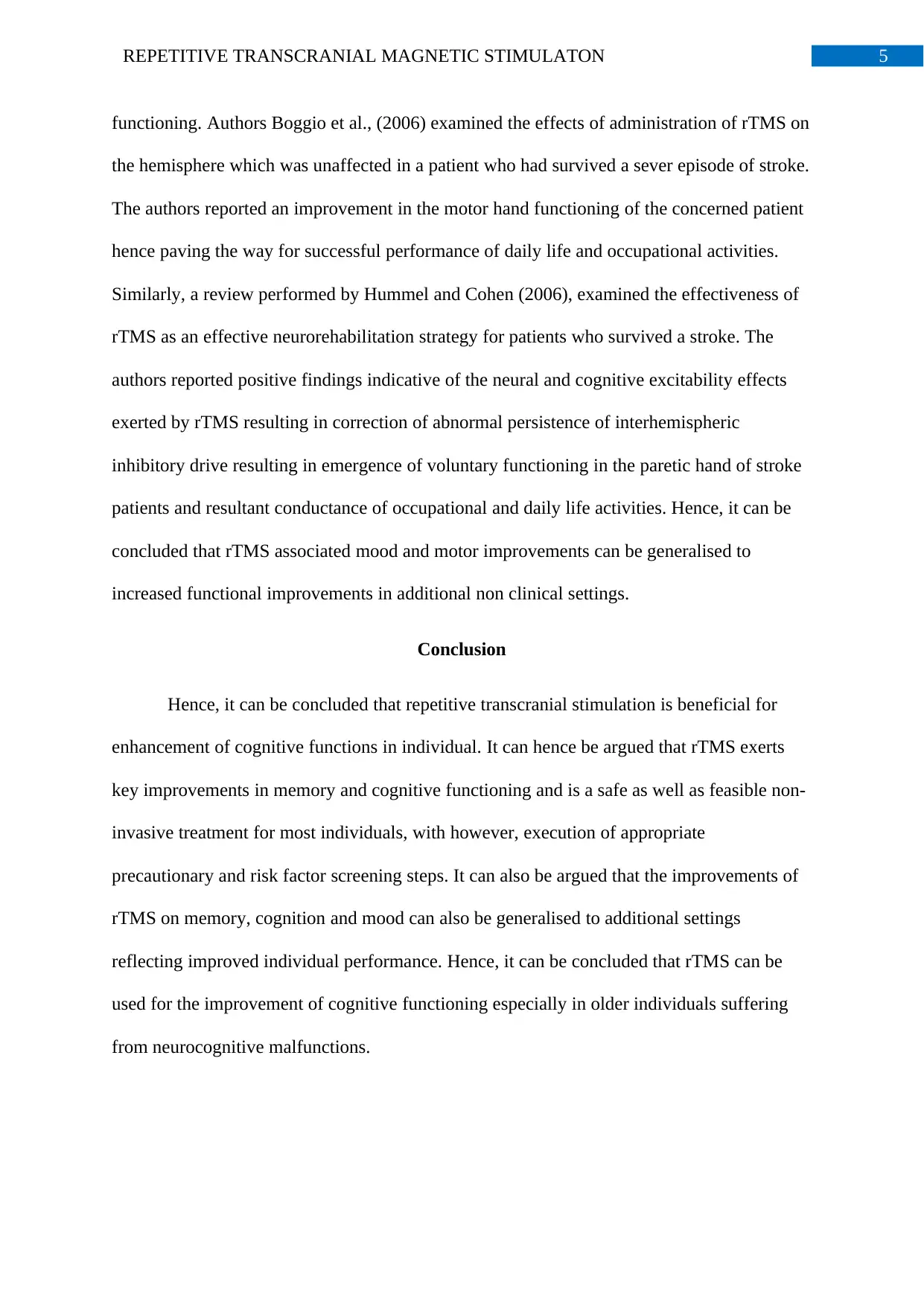
5REPETITIVE TRANSCRANIAL MAGNETIC STIMULATON
functioning. Authors Boggio et al., (2006) examined the effects of administration of rTMS on
the hemisphere which was unaffected in a patient who had survived a sever episode of stroke.
The authors reported an improvement in the motor hand functioning of the concerned patient
hence paving the way for successful performance of daily life and occupational activities.
Similarly, a review performed by Hummel and Cohen (2006), examined the effectiveness of
rTMS as an effective neurorehabilitation strategy for patients who survived a stroke. The
authors reported positive findings indicative of the neural and cognitive excitability effects
exerted by rTMS resulting in correction of abnormal persistence of interhemispheric
inhibitory drive resulting in emergence of voluntary functioning in the paretic hand of stroke
patients and resultant conductance of occupational and daily life activities. Hence, it can be
concluded that rTMS associated mood and motor improvements can be generalised to
increased functional improvements in additional non clinical settings.
Conclusion
Hence, it can be concluded that repetitive transcranial stimulation is beneficial for
enhancement of cognitive functions in individual. It can hence be argued that rTMS exerts
key improvements in memory and cognitive functioning and is a safe as well as feasible non-
invasive treatment for most individuals, with however, execution of appropriate
precautionary and risk factor screening steps. It can also be argued that the improvements of
rTMS on memory, cognition and mood can also be generalised to additional settings
reflecting improved individual performance. Hence, it can be concluded that rTMS can be
used for the improvement of cognitive functioning especially in older individuals suffering
from neurocognitive malfunctions.
functioning. Authors Boggio et al., (2006) examined the effects of administration of rTMS on
the hemisphere which was unaffected in a patient who had survived a sever episode of stroke.
The authors reported an improvement in the motor hand functioning of the concerned patient
hence paving the way for successful performance of daily life and occupational activities.
Similarly, a review performed by Hummel and Cohen (2006), examined the effectiveness of
rTMS as an effective neurorehabilitation strategy for patients who survived a stroke. The
authors reported positive findings indicative of the neural and cognitive excitability effects
exerted by rTMS resulting in correction of abnormal persistence of interhemispheric
inhibitory drive resulting in emergence of voluntary functioning in the paretic hand of stroke
patients and resultant conductance of occupational and daily life activities. Hence, it can be
concluded that rTMS associated mood and motor improvements can be generalised to
increased functional improvements in additional non clinical settings.
Conclusion
Hence, it can be concluded that repetitive transcranial stimulation is beneficial for
enhancement of cognitive functions in individual. It can hence be argued that rTMS exerts
key improvements in memory and cognitive functioning and is a safe as well as feasible non-
invasive treatment for most individuals, with however, execution of appropriate
precautionary and risk factor screening steps. It can also be argued that the improvements of
rTMS on memory, cognition and mood can also be generalised to additional settings
reflecting improved individual performance. Hence, it can be concluded that rTMS can be
used for the improvement of cognitive functioning especially in older individuals suffering
from neurocognitive malfunctions.
⊘ This is a preview!⊘
Do you want full access?
Subscribe today to unlock all pages.

Trusted by 1+ million students worldwide
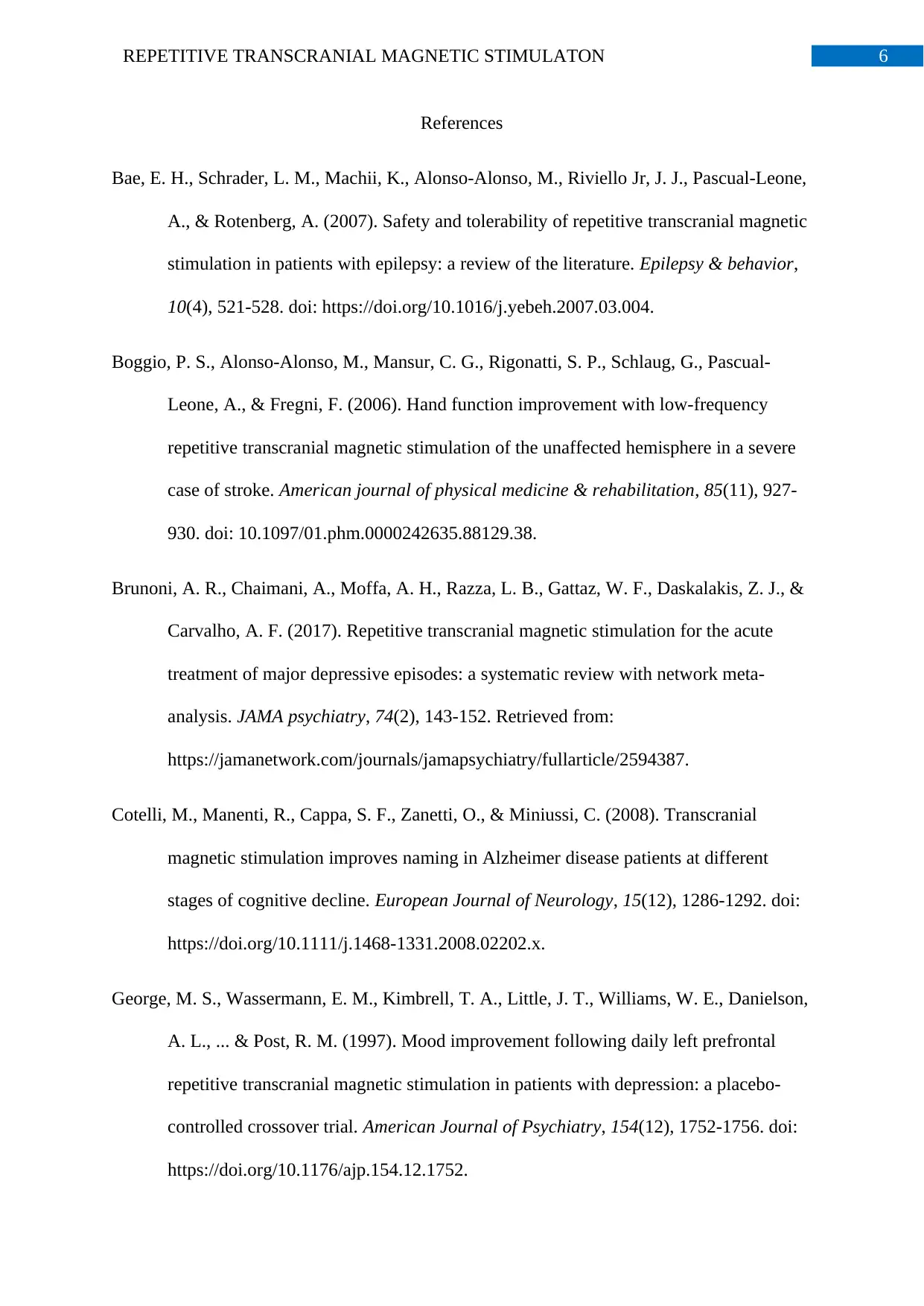
6REPETITIVE TRANSCRANIAL MAGNETIC STIMULATON
References
Bae, E. H., Schrader, L. M., Machii, K., Alonso-Alonso, M., Riviello Jr, J. J., Pascual-Leone,
A., & Rotenberg, A. (2007). Safety and tolerability of repetitive transcranial magnetic
stimulation in patients with epilepsy: a review of the literature. Epilepsy & behavior,
10(4), 521-528. doi: https://doi.org/10.1016/j.yebeh.2007.03.004.
Boggio, P. S., Alonso-Alonso, M., Mansur, C. G., Rigonatti, S. P., Schlaug, G., Pascual-
Leone, A., & Fregni, F. (2006). Hand function improvement with low-frequency
repetitive transcranial magnetic stimulation of the unaffected hemisphere in a severe
case of stroke. American journal of physical medicine & rehabilitation, 85(11), 927-
930. doi: 10.1097/01.phm.0000242635.88129.38.
Brunoni, A. R., Chaimani, A., Moffa, A. H., Razza, L. B., Gattaz, W. F., Daskalakis, Z. J., &
Carvalho, A. F. (2017). Repetitive transcranial magnetic stimulation for the acute
treatment of major depressive episodes: a systematic review with network meta-
analysis. JAMA psychiatry, 74(2), 143-152. Retrieved from:
https://jamanetwork.com/journals/jamapsychiatry/fullarticle/2594387.
Cotelli, M., Manenti, R., Cappa, S. F., Zanetti, O., & Miniussi, C. (2008). Transcranial
magnetic stimulation improves naming in Alzheimer disease patients at different
stages of cognitive decline. European Journal of Neurology, 15(12), 1286-1292. doi:
https://doi.org/10.1111/j.1468-1331.2008.02202.x.
George, M. S., Wassermann, E. M., Kimbrell, T. A., Little, J. T., Williams, W. E., Danielson,
A. L., ... & Post, R. M. (1997). Mood improvement following daily left prefrontal
repetitive transcranial magnetic stimulation in patients with depression: a placebo-
controlled crossover trial. American Journal of Psychiatry, 154(12), 1752-1756. doi:
https://doi.org/10.1176/ajp.154.12.1752.
References
Bae, E. H., Schrader, L. M., Machii, K., Alonso-Alonso, M., Riviello Jr, J. J., Pascual-Leone,
A., & Rotenberg, A. (2007). Safety and tolerability of repetitive transcranial magnetic
stimulation in patients with epilepsy: a review of the literature. Epilepsy & behavior,
10(4), 521-528. doi: https://doi.org/10.1016/j.yebeh.2007.03.004.
Boggio, P. S., Alonso-Alonso, M., Mansur, C. G., Rigonatti, S. P., Schlaug, G., Pascual-
Leone, A., & Fregni, F. (2006). Hand function improvement with low-frequency
repetitive transcranial magnetic stimulation of the unaffected hemisphere in a severe
case of stroke. American journal of physical medicine & rehabilitation, 85(11), 927-
930. doi: 10.1097/01.phm.0000242635.88129.38.
Brunoni, A. R., Chaimani, A., Moffa, A. H., Razza, L. B., Gattaz, W. F., Daskalakis, Z. J., &
Carvalho, A. F. (2017). Repetitive transcranial magnetic stimulation for the acute
treatment of major depressive episodes: a systematic review with network meta-
analysis. JAMA psychiatry, 74(2), 143-152. Retrieved from:
https://jamanetwork.com/journals/jamapsychiatry/fullarticle/2594387.
Cotelli, M., Manenti, R., Cappa, S. F., Zanetti, O., & Miniussi, C. (2008). Transcranial
magnetic stimulation improves naming in Alzheimer disease patients at different
stages of cognitive decline. European Journal of Neurology, 15(12), 1286-1292. doi:
https://doi.org/10.1111/j.1468-1331.2008.02202.x.
George, M. S., Wassermann, E. M., Kimbrell, T. A., Little, J. T., Williams, W. E., Danielson,
A. L., ... & Post, R. M. (1997). Mood improvement following daily left prefrontal
repetitive transcranial magnetic stimulation in patients with depression: a placebo-
controlled crossover trial. American Journal of Psychiatry, 154(12), 1752-1756. doi:
https://doi.org/10.1176/ajp.154.12.1752.
Paraphrase This Document
Need a fresh take? Get an instant paraphrase of this document with our AI Paraphraser
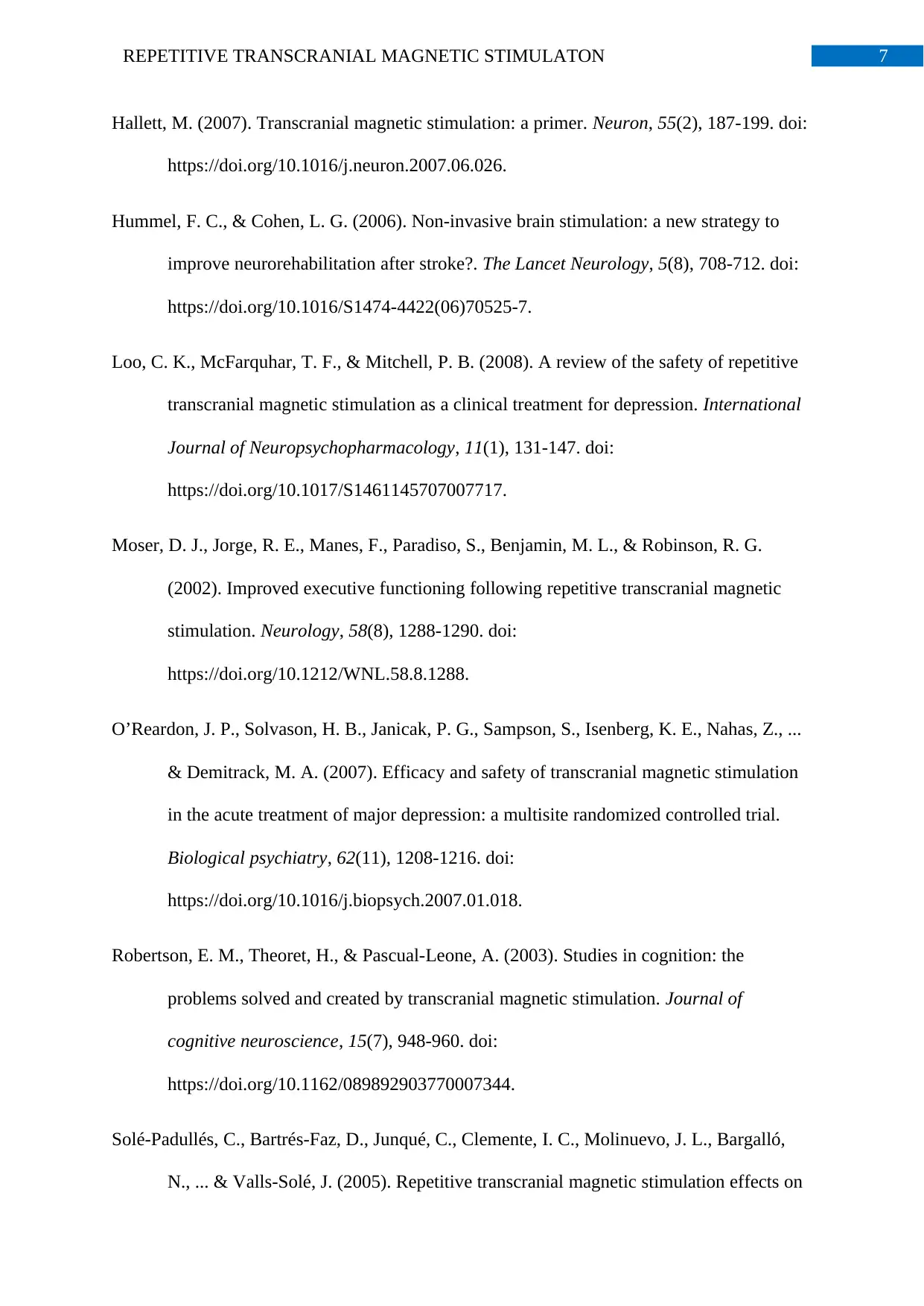
7REPETITIVE TRANSCRANIAL MAGNETIC STIMULATON
Hallett, M. (2007). Transcranial magnetic stimulation: a primer. Neuron, 55(2), 187-199. doi:
https://doi.org/10.1016/j.neuron.2007.06.026.
Hummel, F. C., & Cohen, L. G. (2006). Non-invasive brain stimulation: a new strategy to
improve neurorehabilitation after stroke?. The Lancet Neurology, 5(8), 708-712. doi:
https://doi.org/10.1016/S1474-4422(06)70525-7.
Loo, C. K., McFarquhar, T. F., & Mitchell, P. B. (2008). A review of the safety of repetitive
transcranial magnetic stimulation as a clinical treatment for depression. International
Journal of Neuropsychopharmacology, 11(1), 131-147. doi:
https://doi.org/10.1017/S1461145707007717.
Moser, D. J., Jorge, R. E., Manes, F., Paradiso, S., Benjamin, M. L., & Robinson, R. G.
(2002). Improved executive functioning following repetitive transcranial magnetic
stimulation. Neurology, 58(8), 1288-1290. doi:
https://doi.org/10.1212/WNL.58.8.1288.
O’Reardon, J. P., Solvason, H. B., Janicak, P. G., Sampson, S., Isenberg, K. E., Nahas, Z., ...
& Demitrack, M. A. (2007). Efficacy and safety of transcranial magnetic stimulation
in the acute treatment of major depression: a multisite randomized controlled trial.
Biological psychiatry, 62(11), 1208-1216. doi:
https://doi.org/10.1016/j.biopsych.2007.01.018.
Robertson, E. M., Theoret, H., & Pascual-Leone, A. (2003). Studies in cognition: the
problems solved and created by transcranial magnetic stimulation. Journal of
cognitive neuroscience, 15(7), 948-960. doi:
https://doi.org/10.1162/089892903770007344.
Solé-Padullés, C., Bartrés-Faz, D., Junqué, C., Clemente, I. C., Molinuevo, J. L., Bargalló,
N., ... & Valls-Solé, J. (2005). Repetitive transcranial magnetic stimulation effects on
Hallett, M. (2007). Transcranial magnetic stimulation: a primer. Neuron, 55(2), 187-199. doi:
https://doi.org/10.1016/j.neuron.2007.06.026.
Hummel, F. C., & Cohen, L. G. (2006). Non-invasive brain stimulation: a new strategy to
improve neurorehabilitation after stroke?. The Lancet Neurology, 5(8), 708-712. doi:
https://doi.org/10.1016/S1474-4422(06)70525-7.
Loo, C. K., McFarquhar, T. F., & Mitchell, P. B. (2008). A review of the safety of repetitive
transcranial magnetic stimulation as a clinical treatment for depression. International
Journal of Neuropsychopharmacology, 11(1), 131-147. doi:
https://doi.org/10.1017/S1461145707007717.
Moser, D. J., Jorge, R. E., Manes, F., Paradiso, S., Benjamin, M. L., & Robinson, R. G.
(2002). Improved executive functioning following repetitive transcranial magnetic
stimulation. Neurology, 58(8), 1288-1290. doi:
https://doi.org/10.1212/WNL.58.8.1288.
O’Reardon, J. P., Solvason, H. B., Janicak, P. G., Sampson, S., Isenberg, K. E., Nahas, Z., ...
& Demitrack, M. A. (2007). Efficacy and safety of transcranial magnetic stimulation
in the acute treatment of major depression: a multisite randomized controlled trial.
Biological psychiatry, 62(11), 1208-1216. doi:
https://doi.org/10.1016/j.biopsych.2007.01.018.
Robertson, E. M., Theoret, H., & Pascual-Leone, A. (2003). Studies in cognition: the
problems solved and created by transcranial magnetic stimulation. Journal of
cognitive neuroscience, 15(7), 948-960. doi:
https://doi.org/10.1162/089892903770007344.
Solé-Padullés, C., Bartrés-Faz, D., Junqué, C., Clemente, I. C., Molinuevo, J. L., Bargalló,
N., ... & Valls-Solé, J. (2005). Repetitive transcranial magnetic stimulation effects on
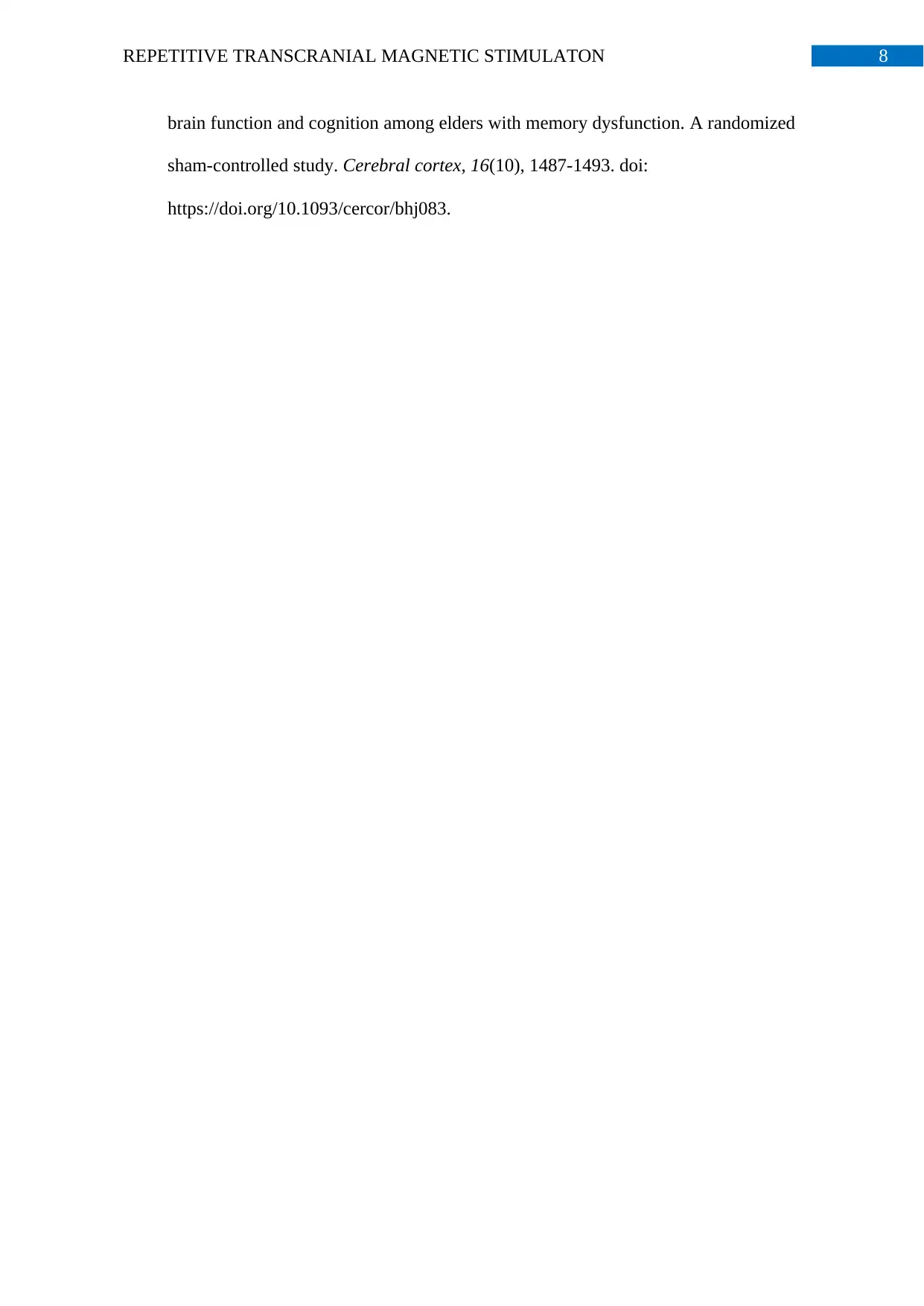
8REPETITIVE TRANSCRANIAL MAGNETIC STIMULATON
brain function and cognition among elders with memory dysfunction. A randomized
sham-controlled study. Cerebral cortex, 16(10), 1487-1493. doi:
https://doi.org/10.1093/cercor/bhj083.
brain function and cognition among elders with memory dysfunction. A randomized
sham-controlled study. Cerebral cortex, 16(10), 1487-1493. doi:
https://doi.org/10.1093/cercor/bhj083.
⊘ This is a preview!⊘
Do you want full access?
Subscribe today to unlock all pages.

Trusted by 1+ million students worldwide
1 out of 9
Your All-in-One AI-Powered Toolkit for Academic Success.
+13062052269
info@desklib.com
Available 24*7 on WhatsApp / Email
![[object Object]](/_next/static/media/star-bottom.7253800d.svg)
Unlock your academic potential
Copyright © 2020–2025 A2Z Services. All Rights Reserved. Developed and managed by ZUCOL.
